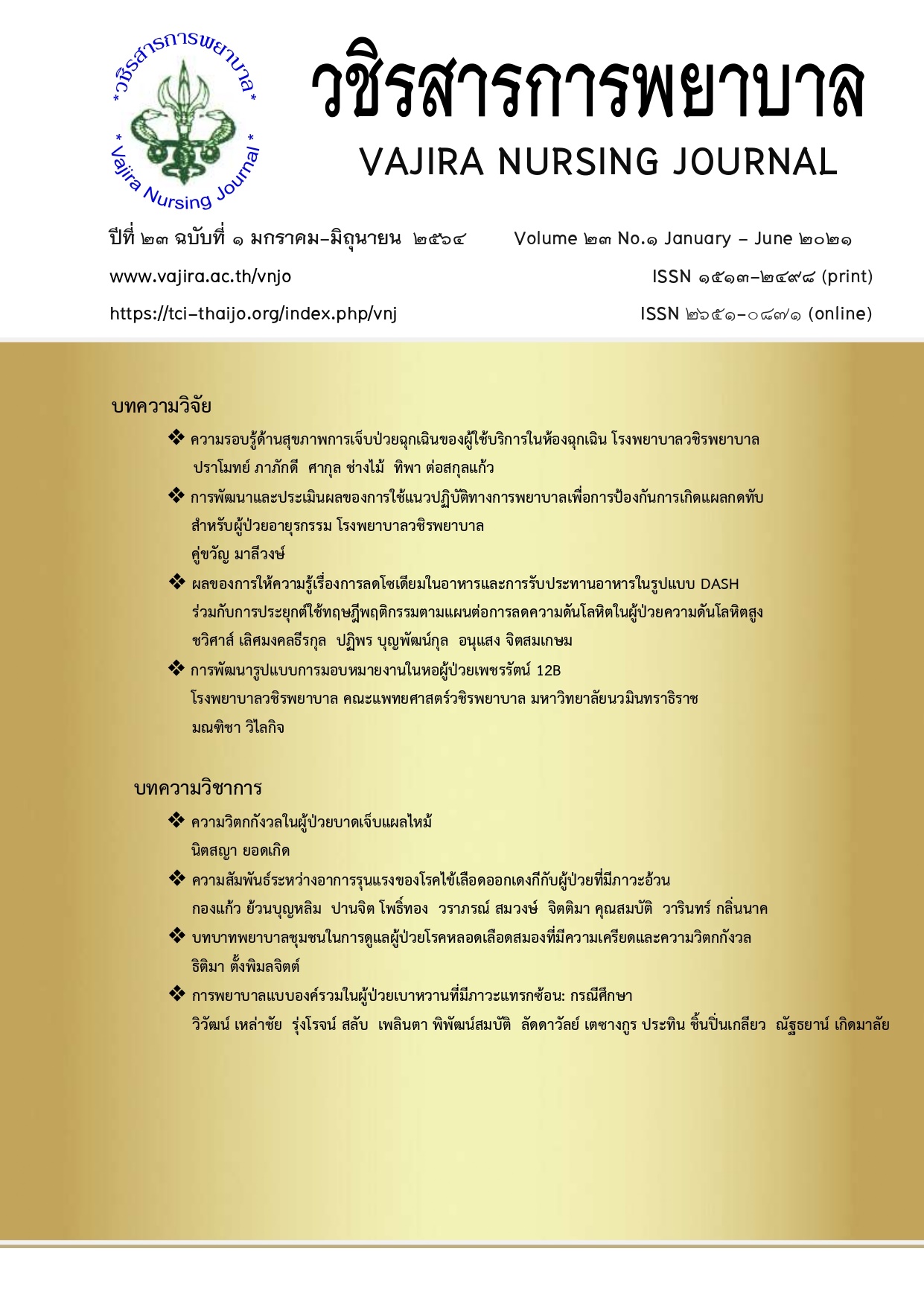ความวิตกกังวลในผู้ป่วยบาดเจ็บแผลไหม้
Main Article Content
บทคัดย่อ
อุบัติเหตุแผลไหม้เป็นอุบัติเหตุเฉียบพลันผู้ป่วยมีพยาธิสภาพการบาดเจ็บเป็นบาดแผลเปิดบนผิวหนังบริเวณกว้าง เมื่อเข้ารับการรักษาในโรงพยาบาล เป้าหมายการรักษาหลักเพื่อให้เกิดการสมานของบาดแผลบนผิวหนัง ปัจจุบันเทคโนโลยีการรักษาบาดแผลความก้าวหน้าไปมากเพราะมีผู้ทำการศึกษาพัฒนาและเผยแพร่องค์ความรู้อย่างต่อเนื่อง แต่ยัง พบว่า การศึกษาในมิติด้านจิตใจของผู้ป่วยยังมีไม่มากนักจึงเป็นโอกาสให้ผู้เขียนทำการศึกษา เรื่องความวิตกกังวลของผู้ป่วยบาดเจ็บแผลไหม้ เพื่อพัฒนาการพยาบาลผู้ป่วยบาดเจ็บแผลไหม้ให้ครบทุกมิติ สร้างความเป็นองค์รวมในการพยาบาลผู้ป่วยบาดแผลไหม้
Article Details

อนุญาตภายใต้เงื่อนไข Creative Commons Attribution-NonCommercial-NoDerivatives 4.0 International License.
เนื้อหาและข้อมูลในบทความที่ลงตีพิมพ์ในวชิรสารการพยาบาลถือเป็นข้อคิดเห็นและความรับผิดชอบของผู้เขียนบทความโดยตรง ซึ่งกองบรรณาธิการไม่จำเป็นต้องเห็นด้วย หรือร่วมรับผิดชอบใด ๆ ทั้งสิ้น
บทความ ข้อมูล เนื้อหา รูปภาพ ฯลฯ ที่ได้รับการตีพิมพ์ในวชิรสารการพยาบาล ถือเป็นลิขสิทธิ์ของวชิรสารการพยาบาล หากบุคคลใดหรือหน่วยงานใดต้องการนำทั้งหมดหรือส่วนหนึ่งส่วนใดไปเผยแพร่ต่อหรือเพื่อกระทำการใด ๆ จะต้องได้รับอนุญาตเป็นลายลักอักษรจากวชิรสารการพยาบาลก่อนเท่านั้น
เอกสารอ้างอิง
ขวัญพนมพร ธรรมไชย (2554). การพยาบาลผู้มีความวิตกกังวลและความเครียดผิดปกติ. การพยาบาลจิตเวชสู่การปฏิบัติ เล่ม 1. โครงการตำราคณะพยาบาลศาสตร์มหาวิทยาลัยเชียงใหม่. เชียงใหม่: ครองช่างพริ้นติ้ง จำกัด.
จิรานุวัฒน์ ชาญสูงเนิน, เพ็ญจันทร์ มณีโชติ และดวงใจ สวัสดี. (2560). ความวิตกกังวลของผู้ดูแลผู้ป่วยบาดเจ็บทางสมอง. วารสารเทคโนโลยีภาคใต้, 10(1), 71-78.
ฉลวย เหลือบรรจงและเนตรนภิศ จินดากร.(2560). แนวทางการดูแลผู้ป่วยที่มีแผลไฟไหม้ น้ำร้อนลวก. วารสารการพยาบาลและการศึกษา, 10(3), 14-22.
บุษบา สมใจวงษ์. (2563). ปัจจัยคัดสรรที่ทำนายความปวดในผู้ป่วยแผลไหม้. วารสารสภาการพยาบาล, 35(3), 34-48.
American Association of Critical-Care Nurses. (2005). Procedure manual for criticalcare. American Journal of Critical Care, 14(3), 187-197.
Anton, B. S. (2009). Proceedings of the American Psychological Association for the legislative year 2008: minutes of the annual meeting of the Council of Representatives, February 22–24, 2008, Washington, DC, and August 13 and 17, 2008, Boston, MA, and minutes of the February, June, August, and December 2008 meetings of the Board of Directors. American Psychologist, 64(5), 372.
Bandura, A. (1977). Self-efficacy: toward a unifying theory of behavioral change. Psychological review, 84(2), 191-215.
Blakeney, P. E., Rosenberg, L., Rosenberg, M., & Faber, A. W. (2008). Psychosocial care of persons with severe burns. Burns, 34(4), 433-440.
Davis, S. T., & Sheely-Adolphson, P. (1997). Burn management. Psychosocial interventions: pharmacologic and psychologic modalities. The Nursing Clinics of North America, 32(2), 331-342.
De Sousa, A., Sonavane, S., & Kurvey, A. (2013). Psychological issues in adult burn patients. Delhi Psychiatry Journal, 16(1), 24-33.
Folkman, S., & Lazarus, R. S. (1984). Stress, appraisal, and coping (p. 460). New York: Springer Publishing Company.
Harjinder, S. B. (2009). Communicating with the caregiver in neurotrauma. Indian Journalof Neurotrauma, 6, 99-102.
Hudak, C. M., Gallo, B. M., & Morton, P.G. (1998). Critical care nursing: A holisticapproach. Philadelphia: Lippincott.
Jampawal, T. (2018). State Anxiety. Journal of Buddhist Psychology, 3(1), 13-20.
Moayedi, M., & Davis, K. D. (2013). Theories of pain: from specificity to gate control. Journal of neurophysiology, 109(1), 5-12.
Nualsrithong, P., Songwathana, P., & Hirunchunha, S. (2006). Fatigue and fatigue management among caregivers of hospitalized patients with head injuries. Songklanagarind MedicalJournal, 24(3), 153-161. [in Thai]
Pandee, D., Kunsongkeit, W., Masinghboon, K., & Wachirawat, W. (2006). Predictors of coping strategies among family members of patients with head injury. Journal of Faculty of Nursing, Burapha University, 14(3), 52-63. [in Thai]
Stuart, G. W., & Sundeen, S. J. (1995). Principle ang Practice of Psychiatric Nursing. St. Louis Missouri. Mosby Year Book Inc.
Schaefer, C., Coyne, J. C., & Lazarus, R. S. (1981). The health-related functions of social support. Journal of behavioral medicine, 4(4), 381-406.
Spielberger, C.D. (Ed.). (1966). Anxiety and Behavior. New York: Academic Press.
Spielberger, C.D., Gorsuch, R.L. (1983). Manual for the State-Trait Anxiety Inventory (Form Y) ("Self-Evaluation Questionnaire).
Testani, D. L., Chappel, A. L., & Eueldner, S. (1992). Traumatic brain injury: A familyexperience. Journal of Neuroscience Nursing, 24, 317-323.


